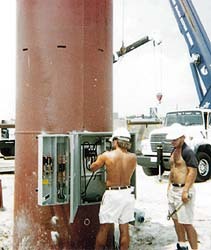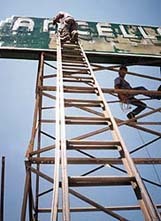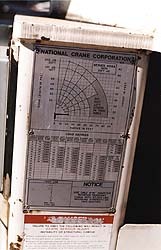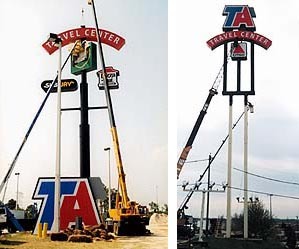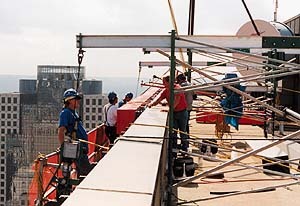With the exception of "IRS," the acronym most likely to strike fear in the hearts of sign-company managers is "OSHA." The Occupational Safety and Health Administration promulgates thousands of regulations affecting nearly every aspect of the American workplace. Many of these regulations directly affect sign-company operations. If you’re not aware of the safety standards that apply to sign projects, you might be courting disaster.
Like other federal regulatory agencies, OSHA prioritizes enforcement of safety standards based on the severity of violations. Periodically, the agency publishes a Top-50 list of the most frequently cited standards. For the six-year period from Jan. 1, 1990 to April 1, 1996, the largest number of violations involved employers who failed to provide fundamental safety education, safety programs, inspections and personal protective equipment. Most of the cited companies failed to observe what OSHA considers minimal workplace safety standards.
Despite some of the horror stories you might have heard, OSHA’s business is to protect workers, not to put your company out of business. Since the agency’s creation in 1970, the incidence of workplace fatalities has decreased by 57 percent. Like the IRS, OSHA looks for patterns of willful behavior that demonstrate disregard for the law. Only in the most flagrant and serious cases does OSHA actually interfere with the operation of a business or shut it down. But the scrutiny precipitated by an employer’s initial violation is frequently a precursor to additional, follow-up inspections. Hence, if your company doesn’t have an organized safety program in place, you risk the future of your business, as well as the health and safety of your employees.
Unwelcome attention
The four main priorities for scheduling OSHA inspections are as follows:
1) Imminent dangers: Any conditions or practices that could cause death or serious physical harm to employees immediately or before enforcement action could be taken. The investigation is conducted within 24 hours.
2) Job-related fatalities/injuries: Any incident that results in the death of an employee or the in-patient hospitalization of three or more employees. Any such incidents must be reported to the nearest OSHA office by telephone or in person within eight hours after the incident.
3) Complaints: If employees, competitors or other interested parties are aware of unsafe conditions or practices that exist in a company, they can file a complaint with OSHA.
4) Programmed inspections: OSHA periodically schedules inspections of "high-hazard" workplaces and job sites.
Sign erectors are particularly susceptible to on-the-spot OSHA inspections, because their work typically is performed along the margins of major highways in clear view of passersby. For example, if an OSHA-compliance officer is driving out to inspect a tire factory, he might pass by a sign-company crew working without the required hardhats or safety belts. The high visibility of sign work dictates that managers and foremen insist on proper safety equipment and procedures.
If an OSHA inspector cites your company with a safety violation (only employers are cited, never employees), you have three options. You can correct the violation and pay the penalty. A second option is to negotiate with OSHA to have the citation or penalties amended or withdrawn. Third, you can appear before OSHA’s Review Commission to contest the citation in toto. The minimum penalty for serious and non-serious willful violations is $5,000. The maximum penalty for a serious, willful violation of OSHA regulations is $70,000.
Crane-related regulations
What safety measures are crucial for sign companies? First and foremost, your company must maintain good safety records. Regardless of your firm’s size, you need an organized safety program based on employee training and a chain of accountability. You must conduct regular, documented inspections of all machinery, cranes, personnel lifts, trucks and other potentially hazardous devices.
For example, if you have five crane trucks assigned to five different foremen, each foreman must be responsible for conducting inspections of his equipment "prior to each use and during use" to ensure safe and proper operation [Standard 1926.550, SubPart N, (a)(5)]. OSHA also requires thorough monthly inspections [(b)(2)] of all truck cranes, and the employer is required to maintain a separate, monthly inspection report for each crane. Each report must include the signature of the person inspecting the crane and the equipment’s serial number. If your company lacks adequate inspection records for equipment, an OSHA inspector will conclude that your firm is careless about safety. This encourages further probing into your company’s safety procedures.
Several specific OSHA regulations affect the operation of crane trucks. Wire rope used for hoisting [(a)(7)] must be removed from service if it becomes frayed, kinked, crushed or otherwise damaged. All moving parts of the crane (belts, gears, shafts, pulleys, drums, chains, etc.) must be guarded [(a)(8)] to prevent contact by employees. Thus, any metal covers that are removed during repairs from a crane or personnel lift must be replaced before putting the equipment back in service. All platforms and walkways attached to the trucks or cranes must have anti-skid surfaces [(a)(13)(iii)].
Other regulations apply to the operation of cranes in the vicinity of power lines. For power lines 50 kilovolts or less, a minimum clearance of 10 feet must be observed between the crane and the electrical wires [(a)(15)(i)]. Also, because a crane frequently extends a substantial distance from the operator’s position, the crane operator must have a "spotter" who watches the tip of the boom to ensure that proper clearance is maintained when working near power lines [(a)(15)(iv)].
All cranes must have legible load-rating charts attached to the equipment in clear view of the operator [(f)(1)(ii)]. Cranes with telescoping booms must incorporate devices to clearly indicate the boom’s extended length and the applicable load radius [(g)(3)(ii)(B)]. Personnel platforms used to hoist workers must incorporate guardrails [(g)(4)(ii)(B)] and have adequate headroom clearance to allow workers to stand upright [(g)(4)(ii)(E)]. Also, personnel platforms should not be used as hoists for tools or other materials that might exceed the rated load capacity [(g)(4)(iii)(C)].
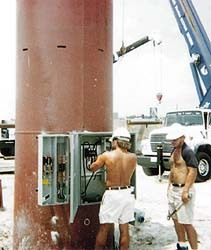

 Tip Sheet2 weeks ago
Tip Sheet2 weeks ago
 Photo Gallery3 days ago
Photo Gallery3 days ago
 Ask Signs of the Times5 days ago
Ask Signs of the Times5 days ago
 Real Deal2 weeks ago
Real Deal2 weeks ago
 Paula Fargo19 hours ago
Paula Fargo19 hours ago
 Benchmarks1 week ago
Benchmarks1 week ago
 Photo Gallery19 hours ago
Photo Gallery19 hours ago
 Women in Signs2 weeks ago
Women in Signs2 weeks ago
